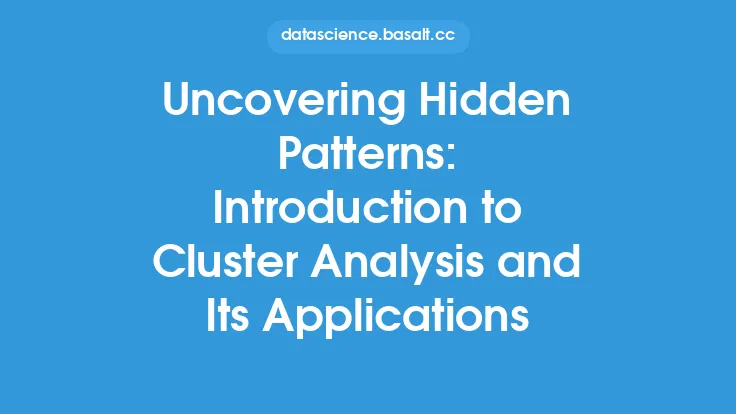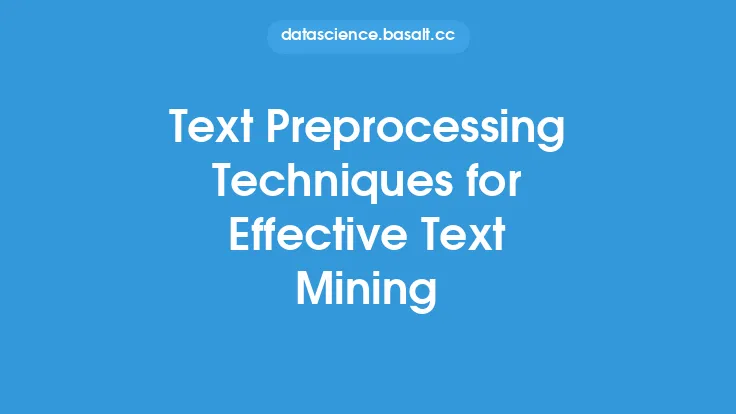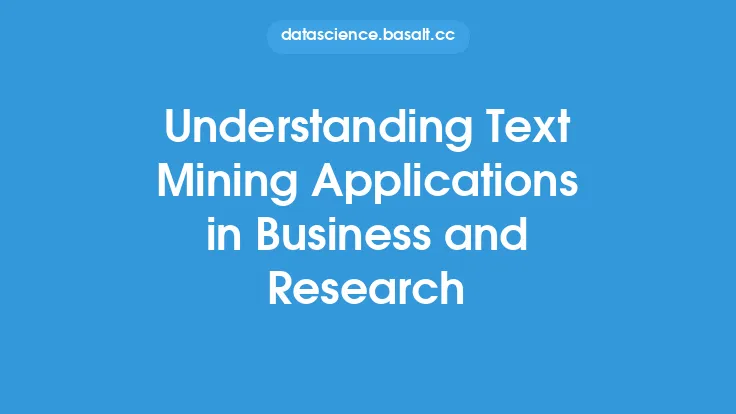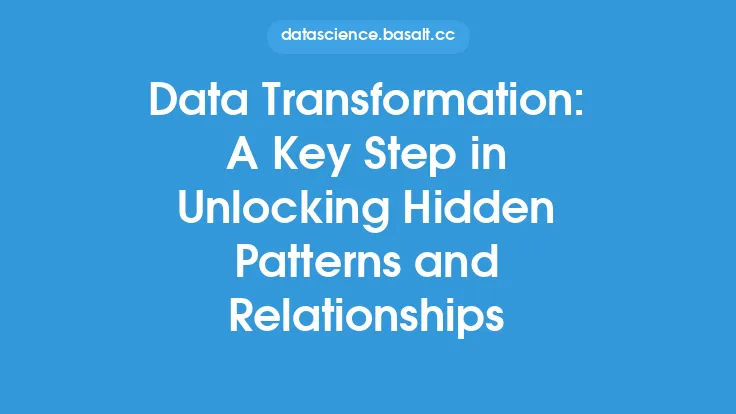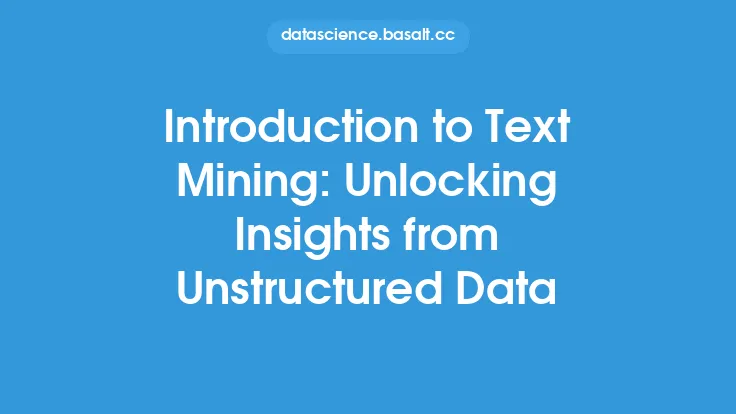Text mining, a subset of data mining, is the process of extracting valuable insights, patterns, and relationships from large amounts of text data. With the exponential growth of unstructured data, text mining has become an essential tool for organizations to uncover hidden patterns, trends, and correlations within their data. In this article, we will delve into the world of text mining techniques, exploring the various methods and algorithms used to uncover hidden patterns in text data.
Introduction to Text Mining Techniques
Text mining techniques are designed to help organizations extract insights from unstructured text data, which can come in various forms, including emails, documents, social media posts, and more. These techniques can be broadly categorized into two main types: supervised and unsupervised learning. Supervised learning involves training a model on labeled data to make predictions on new, unseen data. Unsupervised learning, on the other hand, involves identifying patterns and relationships in unlabeled data. Some common text mining techniques include text classification, clustering, topic modeling, and sentiment analysis.
Text Classification
Text classification is a supervised learning technique used to assign a label or category to a piece of text based on its content. This technique is commonly used in applications such as spam detection, sentiment analysis, and topic modeling. Text classification algorithms work by training a model on a labeled dataset, which is then used to make predictions on new, unseen data. Some popular text classification algorithms include Naive Bayes, Support Vector Machines (SVM), and Random Forest. For example, a company might use text classification to categorize customer feedback as positive, negative, or neutral, allowing them to identify areas for improvement and track changes in customer sentiment over time.
Clustering
Clustering is an unsupervised learning technique used to group similar pieces of text together based on their content. This technique is commonly used in applications such as customer segmentation, topic modeling, and document clustering. Clustering algorithms work by identifying patterns and relationships in the data, which are then used to group similar documents together. Some popular clustering algorithms include K-Means, Hierarchical Clustering, and DBSCAN. For example, a company might use clustering to group customer reviews by topic, allowing them to identify common themes and areas for improvement.
Topic Modeling
Topic modeling is a type of unsupervised learning technique used to identify underlying themes or topics in a large corpus of text data. This technique is commonly used in applications such as document summarization, information retrieval, and text classification. Topic modeling algorithms work by identifying patterns and relationships in the data, which are then used to assign a topic or theme to each document. Some popular topic modeling algorithms include Latent Dirichlet Allocation (LDA), Non-Negative Matrix Factorization (NMF), and Latent Semantic Analysis (LSA). For example, a company might use topic modeling to identify underlying themes in customer feedback, allowing them to identify areas for improvement and track changes in customer sentiment over time.
Information Extraction
Information extraction is the process of extracting specific information or data from unstructured text data. This technique is commonly used in applications such as named entity recognition, part-of-speech tagging, and dependency parsing. Information extraction algorithms work by identifying specific patterns and relationships in the data, which are then used to extract the desired information. Some popular information extraction algorithms include Regular Expressions, Named Entity Recognition (NER), and Part-of-Speech (POS) Tagging. For example, a company might use information extraction to extract specific data points from customer feedback, such as names, locations, and dates, allowing them to track changes in customer behavior over time.
Pattern Discovery
Pattern discovery is the process of identifying underlying patterns and relationships in text data. This technique is commonly used in applications such as text classification, clustering, and topic modeling. Pattern discovery algorithms work by identifying specific patterns and relationships in the data, which are then used to make predictions or identify underlying themes. Some popular pattern discovery algorithms include Association Rule Mining, Sequential Pattern Mining, and Graph-Based Methods. For example, a company might use pattern discovery to identify underlying patterns in customer behavior, allowing them to predict future behavior and make informed decisions.
Evaluation Metrics
Evaluating the performance of text mining models is crucial to ensuring that they are accurate and effective. Some common evaluation metrics used in text mining include accuracy, precision, recall, F1-score, and mean average precision. These metrics provide a way to measure the performance of a model and identify areas for improvement. For example, a company might use accuracy to evaluate the performance of a text classification model, allowing them to identify areas for improvement and track changes in model performance over time.
Real-World Applications
Text mining has a wide range of real-world applications, including customer service, marketing, and research. For example, a company might use text mining to analyze customer feedback, allowing them to identify areas for improvement and track changes in customer sentiment over time. Text mining can also be used to analyze large amounts of text data, such as social media posts or customer reviews, allowing companies to identify underlying patterns and trends. Some other real-world applications of text mining include sentiment analysis, topic modeling, and information extraction.
Challenges and Limitations
While text mining has many benefits, it also has several challenges and limitations. One of the main challenges is the quality of the data, which can be noisy, incomplete, or biased. Another challenge is the complexity of the algorithms, which can be difficult to implement and interpret. Additionally, text mining models can be sensitive to the choice of parameters and the quality of the training data. Some other challenges and limitations of text mining include the need for large amounts of labeled data, the risk of overfitting, and the difficulty of interpreting the results.
Future Directions
The future of text mining is exciting and rapidly evolving. Some of the future directions of text mining include the use of deep learning algorithms, the integration of text mining with other data mining techniques, and the application of text mining to new domains such as healthcare and finance. Additionally, the increasing availability of large amounts of text data and the development of new algorithms and techniques are expected to drive the growth of text mining in the coming years. Some other future directions of text mining include the use of transfer learning, the development of more efficient algorithms, and the application of text mining to real-time data streams.
Conclusion
Text mining is a powerful tool for extracting valuable insights and patterns from large amounts of text data. With its wide range of applications and techniques, text mining has the potential to revolutionize the way organizations make decisions and interact with their customers. While there are challenges and limitations to text mining, the benefits and potential of this technique make it an exciting and rapidly evolving field. As the amount of text data continues to grow, the need for effective text mining techniques will only continue to increase, making this a vital area of research and development in the coming years.
